
Billions of dollars are expected to flow into Internet of Things (IoT) solutions over the next decade, and there is a clear technical use case for decentralized ledger technology to power these solutions.
A number of crypto projects are racing to bring this use case to life at scale, in order to monetize a share of the exponentially growing volume of IoT data. In this article, we give an overview of the IoT market and review the top crypto IoT projects fighting for a piece of it.
Internet of Things Industry Overview
The Internet of Things (IoT) is a term used to describe devices that exchange data with each other and systems via a network.
Common examples of consumer IoT devices include personal fitness trackers and smart home appliances. There is also an increasingly wide variety of IoT devices used behind the scenes in most modern industries, especially manufacturing and logistics businesses, which rely on highly standardized processes.
There will be more than 15 billion IoT devices around the world transmitting over 79 zettabytes (79,000,000,000,000 GB) within a few years, according to Cisco and Statista.
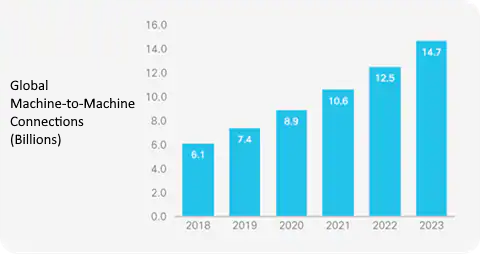
Data volume of IoT connected devices worldwide is projected to mushroom over the next several years:
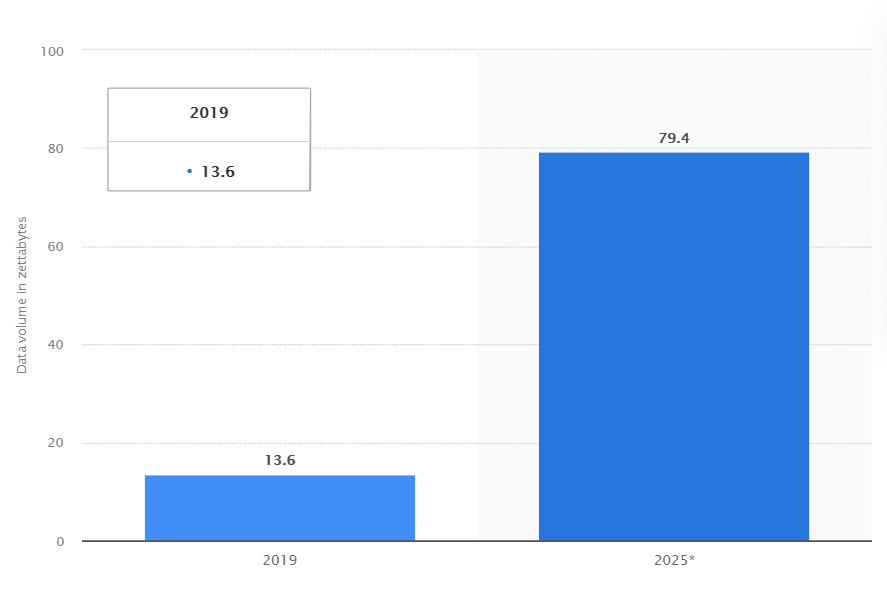
McKinsey estimates that IoT adoption could create up to almost $13 trillion in potential economic value by 2030:
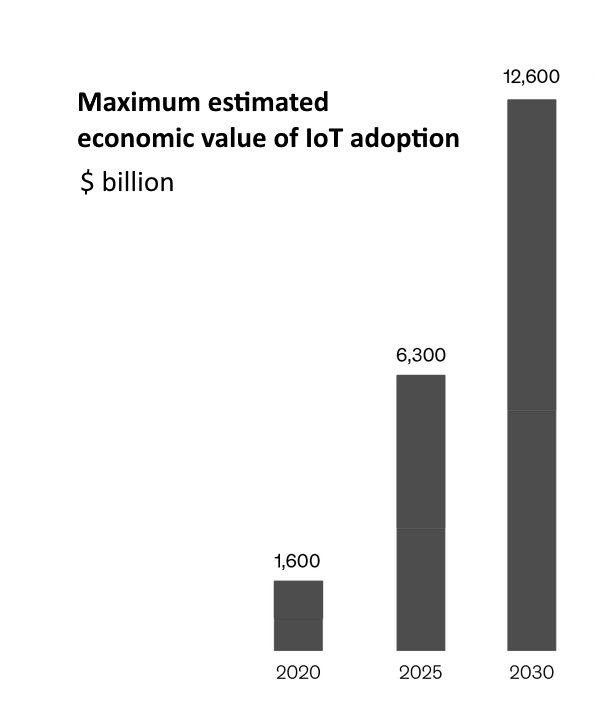
IoT Investment Thesis
Broadly speaking, investments into IoT solutions – regardless of their architecture – are made to capture a chunk of these trillions of dollars worth of potential economic value.
This value can be realized by using IoT data to streamline technology processes. IoT devices can, for example, exchange data amongst themselves to assess overall system performance and automatically make adjustments to optimize it.
With so much potential value to be gained from IoT solutions, it should not be a surprise that the market for them is expected to grow quickly. IoT Analytics estimates that global spending on enterprise IoT solutions will amount to $194 billion in 2022 and will almost triple over the next five years.
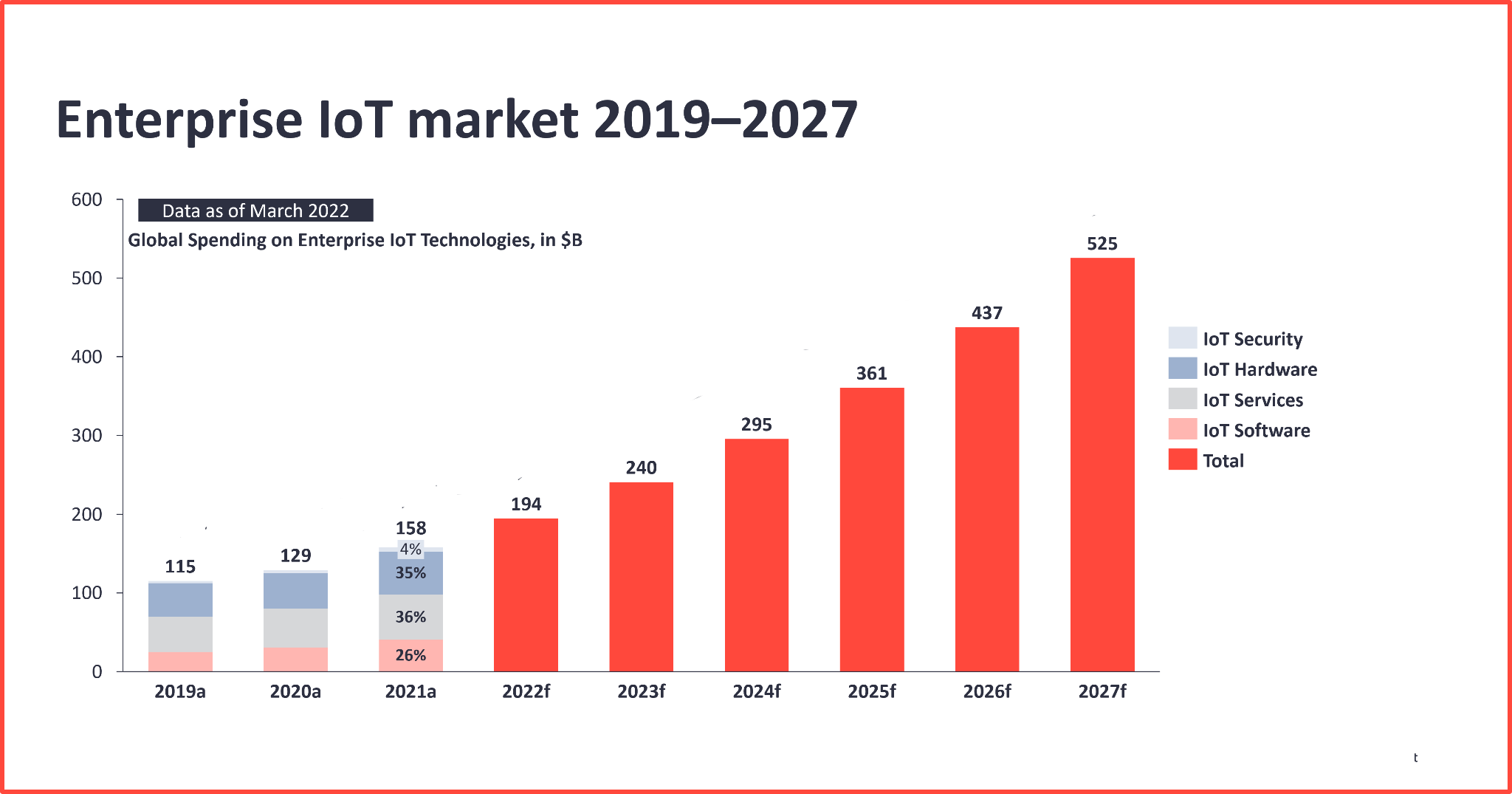
There is a strong case, therefore, to invest in an IoT solution provider as a way to bring some of this spending your way, as institutional investors have noticed. According to Verdict, the ten biggest IoT investment deals made in the first half of 2022 were worth over $1.6 billion in total:
| Lead investor | Deal size | IoT Solution Provider | IoT Solution |
| Magnetar Capital | $215m | Enable Injections | Wearable drug delivery system |
| Accel | $200m | Axonius | Automated IoT security |
| Tiger Global | $200m | Helium | Decentralized wireless network* |
| Coatue Management | $175m | SiFive | IoT semiconductor chips |
| Tencent | $157m | Shenzhen Ou Ruibo Electronics | IoT hardware |
| SoftBank | $156.8m | Eigencomm | Cellular internet of things (IoT) chips |
| Sequoia | $152.6m | Envision Digital | AI / IoT software |
| Alphabet | $140m | Salt Security | API security platform |
| Thomas H. Lee Partners | $130m | KINEXON | IoT sensors |
| FS Investors | $116m | LeddarTech | Vehicle sensors |
Source: Verdict
* Helium’s latest fundraising was primarily to support its pivot from IoT into 5G networking. Helium previously raised over $50m while focusing on IoT.
Decentralized IoT Investment Thesis
The market for IoT solutions is practically begging to be disrupted by decentralized ledger technologies (DLT) like blockchains.
That’s because today’s most popular IoT solutions require data to be routed through centralized databases. Especially as the IoT ecosystem continues to grow and more data must be handled, this “middleman” approach creates scalability risks, tempting targets for hackers, and single points of failure for entire IoT networks.
In comparison, blockchain-based IoT solutions enable devices to interact with each other peer-to-peer (not peer-to-database-to-peer) with an immutable, decentralized record of transactions.
In other words, with decentralized architecture, an IoT solution can do what it is supposed to do – transfer data securely and transparently directly between endpoints – more efficiently than with centralized architecture.
In principle, therefore, a blockchain-based IoT solution provider is playing in a booming market with a clear technical advantage. If the general idea of investing in such a provider doesn’t catch a value investor’s attention, we don’t know what would.
To help you form more specific ideas about which decentralized IoT projects are worth investing in, we’ve listed and reviewed the biggest players below.
Top IoT Crypto Projects
| Project | Ticker | Market Cap | Mainnet Launch Year | IoT Solution | Key Solution Metric |
| VeChainVET | VET | $1,440,561,879 | 2018 | Platform | 40,857,543transactions |
| VTHOR | $45,967,744 | ||||
| IOTA | MIOTA | $611,647,152 | 2016 | Platform | 4,932,377 verified “milestone” transactions |
| Helium | HNT | $311,621,088 | 2019 | Bootstrapped network | 974,919 IoT Hotspots |
| IoTeX | IOTX | $240,779,272 | 2020 | Platform | 53,038,375 transactions |
Each of the leading IoT crypto projects takes a different technical and cryptoeconomic approach to carving out a piece of the IoT market. They all, however, use more or less the same marketing jargon to suggest why their particular approach is the best one.
When reviewing them, we will therefore touch on their decentralized ledger technologies and cryptocurrencies, but our real focus will be on adoption, the metric that matters most.
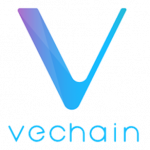 VeChain (VET/VTHOR)
VeChain (VET/VTHOR)
Blockchain tech: The VeChain blockchain, VeChain Thor, is a modified version of Ethereum. The system uses a consensus algorithm called Proof of Authority, which you might think of as Proof of Stake on steroids. Transactions are validated by exactly 101 so-called Authority Nodes run by VeChain-approved operators.
Crypto: VeChain uses two cryptocurrencies, VET and VTHO. By design, most of the system’s value should accrue in VET, and VTHO is used for network transaction fees, in line with the concept of gas on the Ethereum blockchain. Both VET and VTHO are tradeable, but we recommend that crypto value investors concern themselves with VET. The general idea of using VTHO as a separate cryptocurrency for handling network transactions is that its price can be kept low so as to encourage network usage.
Adoption: VeChain has traditionally focused on providing large enterprises with supply chain solutions, e.g. ones that allow buyers to verify the authenticity or origin of products. It is well known for its partnerships with Walmart, PwC, and other big-name brands.
Recently, VeChain has been emphasizing its solutions for carbon tracking, sustainability, and other environmental and social governance (ESG) initiatives.
VeChain burns 70% of transaction costs paid in VTHO, so VTHO burn is a good proxy for how much VeChain is actually being used. According to SeeVeChain, a third-party website that tracks VeChain blockchain data, average daily burn has been at around $150 over the past 7 months.
Our Take: VeChain has an institutional orientation that may appeal to enterprises and governments, especially as ESG grows in popularity. Today, however, VeChain’s impressive roster of partners does not seem to be doing much with the platform. We would expect to see far more VTHO being burned on a daily basis.
 IOTA (MIOTA)
IOTA (MIOTA)
Tech: IOTA is unique among the top IoT crypto projects in that it uses a directed acyclic graph (DAG) as opposed to a blockchain. IOTA calls its DAG “The Tangle.” In a DAG, network users validate other users’ transactions but not their own. The transactions are linked to each other instead of going into blocks to be validated as they are in a blockchain. The key advantage of a DAG over a blockchain is that there are no transaction fees.
Crypto: MIOTA (one million IOTA) is the tradeable digital asset associated with IOTA.
Because there are no transaction fees in the IOTA system, there is no demand for MIOTA to pay them. A value investor may wonder, therefore, what would drive demand for MIOTA apart from speculation.
Based on an IOTA blog article, the team appears to be working on something like a “refundable deposit” mechanism in which users lock up a certain amount of IOTA while using the system. For example, if a business wants to create a unique identifier for a customer in the form of an NFT then a certain amount of IOTA would be locked up for as long as the NFT existed in the IOTA Tangle. If the NFT is no longer required, the issuer “archives” the data and the deposit is returned.
In other words, the idea appears to be that as demand for system services goes up, then token supply will go down, leading to higher prices.
Adoption: IOTA is partnering or collaborating with over 100 enterprises, including Jaguar and Dell. Network adoption, however, has been slow.
The system is still using Coordinators, which are basically trusted validators put in place temporarily until there are enough overall users to validate each others’ transactions properly in the Tangle. Since mid-2021 the team has been officially aiming to eliminate Coordinators in what they call “coordicide” as part of IOTA 2.0. Many investors have been discouraged by IOTA’s slow progress, which might be due to not having a sufficient user base.
Our Take: Over the long term, thanks to its DAG architecture, IOTA has perhaps the most potential of any crypto IoT project, but progress towards driving usage has been slow. Also, the “refundable deposit” concept – apparently the only mechanism that would lead to MIOTA price growth other than speculation – is largely unproven.
For the value of MIOTA to go up and stay up, it seems that many big organizations will need to digitally transform themselves around the IOTA platform. (The IOTA team appears to be envisioning this scenario.)
Large-scale digital transformations, however, typically require significant time for pilot tests, proofs of concept, and so forth. It may be a while before major businesses and governments decide to launch IOTA-based systems, let alone roll them out. Until then, not enough IOTA may be deposited at any one time to keep the price of MIOTA up.
 Helium (HNT)
Helium (HNT)
Tech: Helium is migrating from its own native blockchain to the Solana Layer 1 blockchain (which is currently going through a crisis of confidence following the FTX meltdown).
In addition to accounting for data transfers, Helium’s blockchain is designed to reward people for launching nodes (which Helium calls Hotspots) to provide coverage for Helium networks. Helium originally focused on bootstrapping a network for IoT data but recently began rolling out a separate network for 5G data. (See our Investor’s Guide to Helium.)
Crypto: Helium’s primary cryptocurrency is HNT. As of mid-2022, each Helium network will use its own token (a Decentralized Network Token or DNT in Helium terminology) to reward node operators. HNT serves as a “reserve currency” that DNTs can be exchanged for, but not vice versa. Network users must exchange HNT for Helium Data Credits to pay for data transfers.
IOT is the Helium IoT network token. As of this writing, IOT can only be obtained by running a Helium IoT node, i.e. it cannot be bought on any crypto exchange.
Adoption: On its website, Helium highlights a number of IoT device manufacturers that use its network. Even so, its IoT network has seen very little usage from companies or device manufacturers.
Helium publishes statistics on Data Credit spending but does not appear to distinguish which Helium network the Data Credits are being spent to use.
Recent statistics indicate that only around $6,000 worth of Data Credits were spent on Data Credit transfers over the last month. That’s not a very impressive figure for a network with almost 1 million nodes, especially considering that a significant chunk of that spending is most likely going towards usage of Helium’s new 5G network.
Our Take: Poor adoption of Helium’s IoT was likely a key factor behind Helium’s pivot into the 5G networking space in 2022. Helium is not shutting down its IoT network, but we can reasonably expect that the team’s focus will be elsewhere moving forward. We recommend that you focus elsewhere too, until Helium can prove its success in the 5G space.
 IOTEX (IOTX)
IOTEX (IOTX)
Tech: IoTeX runs on its own blockchain. For consensus it uses Roll-DPoS, a variation of the Delegated Proof of Stake algorithm based on rolling time periods or epochs in which nodes are voted into temporary block producer/validator duty by other nodes.
Crypto: IOTX is the IoTeX blockchain’s native asset. Network users can use it to pay for data transactions or stake it. To encourage network growth, some IOTX is burned and some is airdropped to stakers when new devices are added to the ecosystem. Device manufacturers also burn IOTX when using new IoteX services via a “Burn-to-Certify” mechanism. According to plan, providers of services on the IoTeX blockchain will be required to deposit IOTX in line with what IoTeX calls “stake-to-service.”
Adoption: IoTeX has launched two consumer IoT devices. One is Pebble, a $215 pager-sized device that tracks location, light, and other features of a user’s environment. The other is Ucam, a $59.99 home security camera. There are a total of 16,169 devices registered on the IoTeX network as of this writing.
In August 2022, IoTeX launched its MachineFi (machine finance) portal for decentralized app (dApp) developers and users. Users can earn IoTeX for connecting their devices and using these dApps. In March 2022, the IoTeX Foundation raised a $100 million fund to back developers of dApps – including MachineFi apps – that can take advantage of IoTeX.
According to Messari research from August 2022, there has been healthy usage of IoTeX-friendly dApps as measured by the number of IOTX smart contract transactions vs other IOTX transaction types. In other words, the IoTeX network appears to be being used, not just built.
Our Take: We like IoTeX’s emphasis on driving user demand. Of all the leading IoT crypto projects, IoTeX seems to be giving users the most straightforward and understandable path to plugging into an IoT network and quickly benefiting from it. Judging from network activity, users do appear to be taking this path.
In principle, IoTeX’s “stake-to-service” mechanism should eventually push up the price of IOTX as tokens are locked up by service providers and supply is reduced accordingly. In the meantime, the requirement to pay for network transaction fees with IOTX will likely provide a more familiar reason to invest in the cryptocurrency.

Investor Takeaway
Crypto value investors should be paying close attention to the decentralized IoT space. In general, IoT is one of the most attractive growth industries of the future, and blockchain technology has exciting potential to power it.
Whether a particular crypto IoT project will actually deliver on this potential, however, will depend primarily on its adoption. Elegant technology will not matter much if no one sees the point of using it.
So far, Helium has not executed on this principle very well, and we do not expect they will in the future, at least with respect to their IoT network. Neither has VeChain, but its “enterprisey” feel may click with some organizations jumping on the increasingly large ESG bandwagon.
We therefore recommend that you focus your IoT crypto research efforts on IOTA and IoTeX.
IOTA appears to be approaching the market from the top-down, i.e. building solutions for large, relatively slow-moving organizations with long-term plans to leverage data from people who won’t necessarily want or need to know anything about crypto.
IoTeX, on the other hand, seems to be taking more of a bottom-up approach with solutions designed to give users easily understandable crypto benefits here and now.












More Stories
U.S. Congressmen Seek Information Over Govt’s Crypto De-bank Efforts
Is It Worth Trading in Forex Markets in 2023?
Ethereum Outshines Bitcoin As Enthusiasm Grows